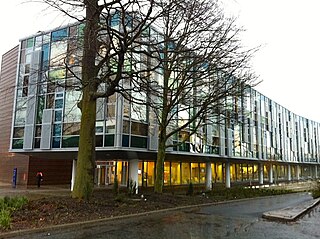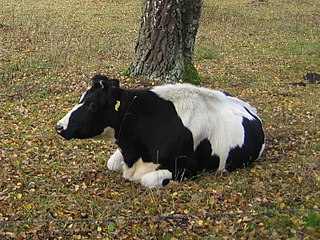Related Research Articles

Niranam is a village in Thiruvalla, Kerala, India. It was a port in ancient Kerala, on the confluence of the Manimala and Pamba River. It is almost 7 km from Tiruvalla SCS Junction in Pathanamthitta District of Kerala, lies to the western part of Tiruvalla, identified as Upper Kuttanad region. It Is Part Of Thiruvalla Sub-District.Also Comes Under Thiruvalla Constituency.It is identified with Nelcynda in Periplus of the Erythraean Sea.

The Belted Galloway is a traditional Scottish breed of beef cattle. It derives from the Galloway stock of the Galloway region of south-western Scotland, and was established as a separate breed in 1921. It is adapted to living on the poor upland pastures and windswept moorlands of the region. The exact origin of the breed is unclear, although the white belt for which they are named, and which distinguishes the breed from black Galloway cattle, is often surmised to be the result of cross-breeding with the similarly-coloured Dutch Lakenvelder.

Vechur is a breed of zebu cattle, named after the village of Vechoor in Kerala, India. With an average length of 124 cm and height of 87 cm, it is the smallest cattle breed in the world according to the Guinness Book of Records, and is valued for the larger amount of milk it produces relative to the amount of food it requires.

College of Veterinary and Animal Sciences is a veterinary college located at Mannuthy, Thrissur city of the Indian state of Kerala. The college is part of Kerala Veterinary and Animal Sciences University.

Kerala Agricultural University (KAU) is a state university for agricultural education, recognised as a State Agricultural University by the Indian Council of Agricultural Research (ICAR). It is situated in Vellanikkara, Kerala, India.
The Agerolese is a breed of dairy cattle from the area of Agerola, in Campania in southern Italy. It is particularly associated with the Sorrento Peninsula and Monti Lattari. It derives from cross-breeding of indigenous Podolica cattle with Italian Holstein-Friesian, Bruna Italiana and Jersey cattle. It is one of the sixteen minor Italian cattle breeds of limited diffusion recognised and protected by the Ministero delle Politiche Agricole Alimentari e Forestali, the Italian ministry of agriculture.

Kalmyk cattle is a breed of beef cattle of the former Soviet Union, now found in the Russian Federation, in Kazakhstan and in Tajikistan. It is believed to have originated in Dzungaria, and to have been brought into south-eastern Russia by migrating Kalmyks in the seventeenth century.

The Ukrainian Grey is an ancient Ukrainian breed of Podolian cattle. It is a hardy breed, and was traditionally used both for meat and for draught power. It is similar to other European steppe cattle breeds such as the Hungarian Grey and the Italian Podolica.

The Armoricaine or Armorican is an endangered French breed of domestic cattle. It originated in Brittany in the nineteenth century. It has a red coat with white markings, and has short horns.

The Ringamålako is an endangered Swedish breed of dairy cattle. It is named for the village of Ringamåla in the southern Swedish county of Blekinge, and is found primarily in southern Sweden. It is similar to the type of Swedish Red-and-White cattle of the 1940s, and is considered a valuable genetic resource.
Miniature cattle are found in various parts of the world. Some, such as the Dexter of Ireland and the Vechur of Kerala, India, are traditional breeds; others have been created by selective breeding. The Australian Lowline was the unexpected result of a scientific experiment. Some, but not all, miniature breeds display achondroplasia, or dwarfism.

The Telemarkfe or Telemark is a traditional Norwegian breed of dairy cattle. It originated in, and is named for, the county of Telemark in central southern Norway. In the second half of the nineteenth century it spread – with official encouragement – to most of the eastern and southern part of the country. In the twenty-first century it is an endangered breed, with a total population of fewer than 600 head.

The Fjäll is a traditional Swedish breed of polled mountain cattle. It was threatened with extinction in the 1970s and 1980s, but recovered after a breed association was formed in 1995, partly thanks to stocks of frozen semen. Microsatellite analysis has shown it to be closely related to the endangered Bohuskulla breed.

Kerala Veterinary and Animal Sciences University (KVASU) is a university established by the Government of Kerala in December 2010 to further education, research and extension services in the field of Veterinary and Animal Sciences. The territorial jurisdiction of the university extends to the whole of the State of Kerala. Its headquarters is located at Pookode near Kalpetta in Wayanad District in Kerala State.

Ongole cattle as called as Ongolu Gitta are an indigenous cattle breed that originates from Prakasam District in the state of Andhra Pradesh in India. The breed derives its name from the place the breed originates from, Ongole. The Ongole breed of cattle, Bos indicus, is in great demand as it is said to possess resistance to both foot and mouth disease and mad cow disease. These cattle are commonly used in bull fights in Mexico and some parts of East Africa due to their strength and aggressiveness. They also participate in traditional bull fights in Andhra Pradesh and Tamil Nadu. Cattle breeders use the fighting ability of the bulls to choose the right stock for breeding in terms of purity and strength. The mascot of the 2002 National Games of India was Veera, an Ongole Bull.

The Roslin Institute is an animal sciences research institute at Easter Bush, Midlothian, Scotland, part of the University of Edinburgh, and is funded by the Biotechnology and Biological Sciences Research Council.

The Väneko is an endangered Swedish breed of dairy cattle. It is named for the village of Väne-Ryr in the landskap of Västergötland, in western Sweden. It is a traditional domestic Swedish breed, and derives from a group of cattle discovered in the 1990s, at a time when all traditional Swedish horned cattle were thought to have disappeared.

The Swedish Friesian, Swedish: 'Svensk Låglandsboskap', often abbreviated to SLB, is a Swedish breed of dairy cattle. It was established in about 1870 from imports of cattle of Dutch Friesian or German Black Pied type. From about 1970 it has been systematically cross-bred with the American Holstein-Friesian breed, to the point that the original Swedish type may be extinct. The name Swedish Holstein may also be used.It is a type of Swedish cattle breed.

The Bohuskulla is an endangered Swedish breed of hornless mountain cattle. It originates from the area of the Kynnefjäll plateau in northern Bohuslän and Dalsland, in western Sweden. It is a traditional domestic Swedish breed, and derives from a group of cattle discovered in the 1990s in Skepplanda, in Västergötland, close to the border with Bohuslän. Microsatellite analysis has shown it to be closely related to the Fjällko mountain cattle of Sweden.
References
- 1 2 3 "ശോശാമ്മ ഐപ്പ് ഉയരം കുറഞ്ഞതിനെ തേടി; ഇപ്പോൾ 'ഉയരം' രാജ്യത്തോളം". ManoramaOnline (in Malayalam).
- 1 2 3 4 "വെച്ചൂർ പശുക്കളുടെ സ്വന്തം വെച്ചൂർ അമ്മ; പത്മശ്രീയിൽ തിളങ്ങി ശോശാമ്മ ഐപ്പ്". Manoramanews.
- ↑ Daily, Keralakaumudi. "ലേഖനമെഴുതാൻ അന്വേഷിച്ചു; വെച്ചൂർ പശുവിന്റെ പോറ്റമ്മയായി". Keralakaumudi Daily.
- 1 2 3 4 5 6 7 8 സേതുമാധവന്, ഡോ ടി പി. "കല്ലും മുള്ളും താണ്ടി ഡോ.ശോശാമ്മ ഐപ്പ് തീര്ത്ത 'വെച്ചൂര് വിപ്ലവം'". Mathrubhumi (in Malayalam).
- 1 2 3 4 "Holy Cow Small Packs a Big Punch". The New Indian Express . 20 December 2014.
- 1 2 Choubey, Alin. "Conservation of Vechur Cattle by Dr. Sossama Iype, Kerala – Nature-based solutions".
- ↑ Jan 26, T. Ramavarman /. "vechur: Honour For Her Conservation Efforts | Kochi News - Times of India". The Times of India.
{{cite news}}: CS1 maint: numeric names: authors list (link) - ↑ "Sosamma Iype awarded India Biodiversity Award for her conservation work with Vechur cattle". iMalayalee MultiChannel News Portal. 27 May 2016.